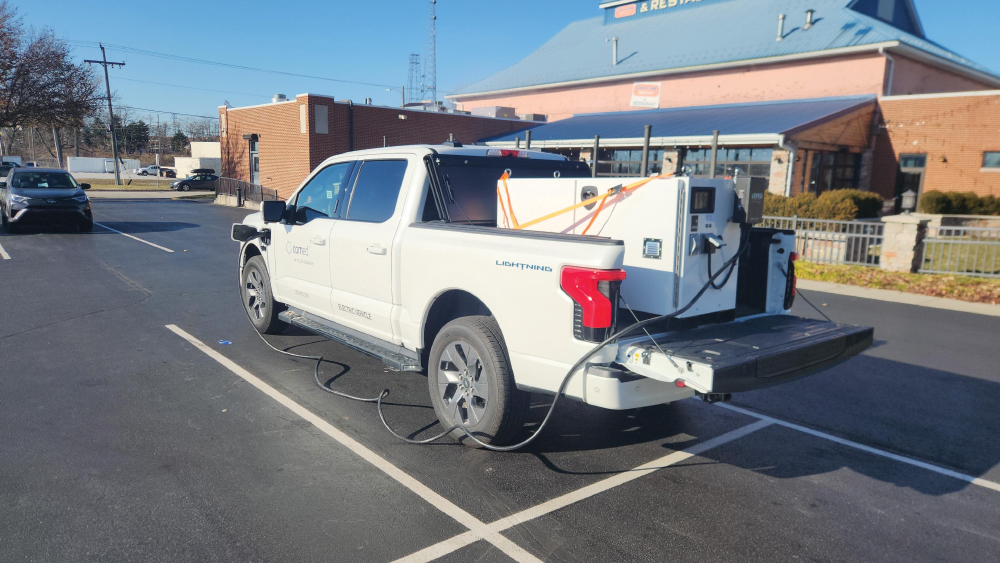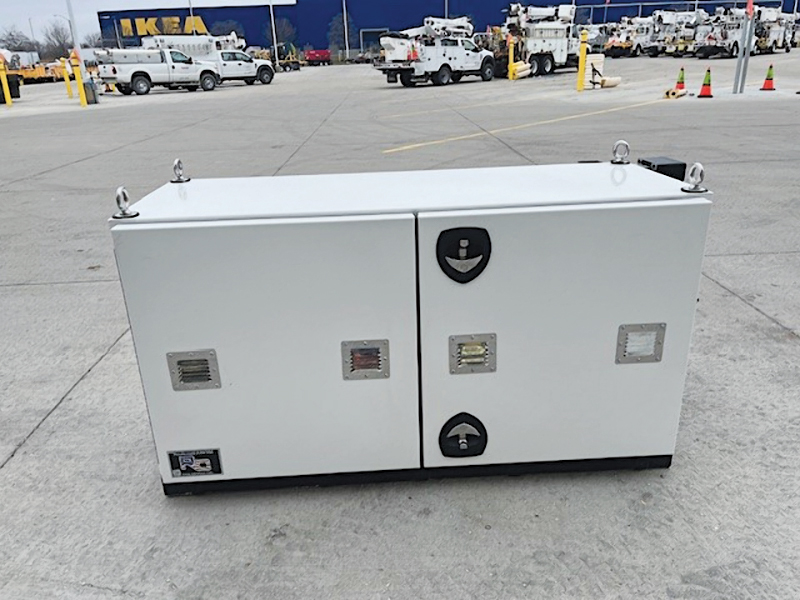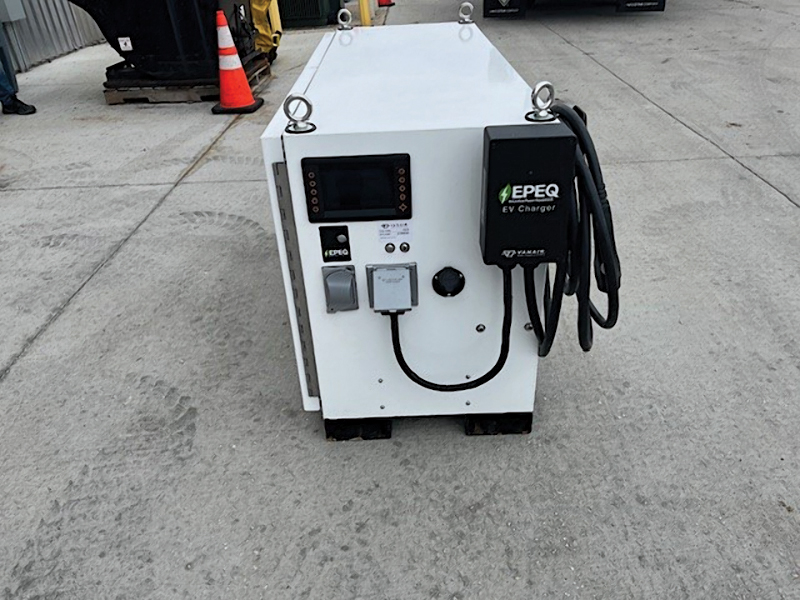Covering 11,000 square miles in northern Illinois stretching from Lake Michigan to Iowa and from Dixon to Wisconsin, ComEd utility crews have a lot of ground to cover to ensure the grid is well maintained and operational for its 4 million customers — roughly 70% of Illinois’ population.
The team charged with taking care of the most reliable grid in the country has always found innovative solutions to the challenges the utility industry faces, whether that be through proactive grid hardening, enhanced storm recovery tactics or advanced smart grid technology. As the world moves toward a more sustainable future, ComEd is leading the charge by electrifying its fleet and embracing innovative solutions to support a growing number of electric vehicles (EVs).
As the latest example of the company’s commitment to reduce its environmental footprint and enhance the efficiency of its operations, ComEd’s Fleet Services team has introduced an Emergency Roadside Charger (ERC) within the company. The ERC is a first-of-its-kind mobile charging system, built by Vanair, to provide emergency roadside charging for ComEd’s electric fleet vehicles.
ComEd has a substantial electric fleet, with a mix of over 550 fully electric, plug-in hybrid and idle-mitigation vehicles included. As the number of ComEd electric vehicles continues to grow, the Fleet Services team saw the need to introduce an emergency roadside assistance solution for its EVs.
Meet ComEd’s emergency roadside charger
If a gas-powered vehicle in a fleet were to run out of fuel or discover it had a drained engine battery, it could be quickly revived by a colleague giving them a jump start or bringing a small tank of gas to their location. Unfortunately, neither of those solutions is the right fit for an EV, which prompted ComEd to explore innovative solutions to meet this need.
ComEd’s ERC features a 10-kWh lithium-ion battery pack with a built-in EV charging station. This mobile charger can provide a ComEd fleet vehicle with approximately 30 miles of range following a one-hour charge in the field.
This roadside charging solution was designed with flexibility in mind. The ERC can be placed in the back of nearly any ComEd pickup or mechanic truck and driven out into the field to support a vehicle whose battery has been depleted.
When ComEd first began looking into mobile charging stations, the solutions they found were intended to be permanently mounted to a single fleet vehicle. Once ComEd took ownership of its first Emergency Roadside Charger in January 2024, the team installed forklift pockets on the bottom and lifting rings on the top so that the 270-pound ERC could be placed into a ComEd pickup or mechanic truck via forklift or crane.
The best emergency backup plans are the ones that can be executed quickly, and designing the ERC to not be anchored to a specific vehicle makes the charging technology more nimble.
ComEd is currently housing the ERC at one of its fleet garages, where it will remain fully charged until needed. Within 30 minutes or less of receiving a support call from the field, the charger can be safely loaded into any available vehicle and deployed. If ComEd had permanently mounted the ERC to a single vehicle, more coordination and time would likely have been required to have the ERC vehicle deployed to support the drained fleet vehicle.
Following the ERC pilot program, ComEd hopes to expand its ERC network to have mobile chargers placed at reporting centers throughout its service territory to support its growing EV fleet.
A (charging) port in a storm
During storm recovery efforts, keeping utility crews mobile is crucial for quick recovery and maintaining customer satisfaction. ComEd is part of three mutual assistance networks that support 30 states, often sending vehicles and crews to support restoration efforts across the country. With the number of EV fleet vehicles rising each year, being able to bring a backup charging solution to support ComEd and local EV fleet needs is an added bonus to having ERCs in a utility’s solutions portfolio.
Beyond having EV charging capabilities, the ERC has a built-in inverter designed to support other 110w crew power needs when out in the field. From charging battery-powered hand tools and electronics to powering scene lighting to help ensure work is completed safely, the ERC has a variety of use cases, and both the inverter and EV charger can be utilized at the same time.
Keeping ComEd’s fleet and crews operational
Electrifying a fleet has more steps than simply purchasing an EV. ComEd has made facility upgrades across its territory and added more than 500 charging stations to support its growing EV fleet. With many of the ComEd EV fleet vehicles having ranges of at least 300 miles from a full charge in standard operating condition, a full battery should be more than enough to complete the expected workload of a given day. However, unforeseen circumstances like severe weather or time-intensive repairs can lead to battery depletion — requiring a backup plan. Having a mobile charger to support the fleet allows the ERC to be both a reactive and proactive tool to ensure the fleet remains operational.
While ComEd has never had a fully electric vehicle experience battery depletion in the field, the team feels preparing for the worst is the key to success. The ERC hasn’t been needed in an emergency yet, but through the ongoing pilot, the Fleet Services team is building a better understanding of charging needs for its fleet vehicles and identifying locations throughout its service territory where ERCs can be most impactful.
ComEd expects to continue building necessary support programs to complement its increasing green fleet as the utility continues to ensure the highest levels of service for customers amid the clean energy transition.
Leading by example
ComEd recognizes that the grid will need to work in new ways to enable millions of electric vehicles that are hitting the roads and plugging in. Electric service must remain reliable and resilient for customers, and one way ComEd is achieving this is through the implementation of innovative programs like the ERC pilot program.
In 2023, ComEd announced its 2030 plan, which sets out a vision of how the company’s investments in its infrastructure and customer programs can advance critical policy goals, including the goals of the landmark Climate and Equitable Jobs Act (CEJA) which aims to decarbonize Illinois’ power sector by 2025.
The ComEd 2030 plan is supported by five pillars to guide ongoing work to serve customers and communities. Two of the pillars focus on economywide decarbonization powered by a carbon-free grid and enabling our customers to simply make cleaner energy choices.
ComEd expects its grid will be capable of delivering 100%, 24/7 carbon-free power in northern Illinois that will enable increasingly electrified transportation, building and industrial sectors. In support, ComEd has set a 2030 target of being able to support up to 1.8 million electric vehicles on the road in northern Illinois. ComEd hopes that its customers will continue to adopt carbon-free solutions in their daily lives, and as a company, feels it’s important to walk the walk when it comes to transportation electrification.
The ComEd 2030 plan is coordinated with parent company Exelon’s “Path to Clean,” which in addition to setting goals to reduce operations-driven emissions across the company’s businesses by 50% by 2030 and achieve net-zero operations by 2050, commits to electrifying 50% of its utility fleet vehicles through a combination of fully electric vehicles, plug-in hybrids and vehicles with build in idle-mitigation capability by 2030. Beyond reducing company emissions, Path to Clean is focused on supporting customers and communities in reaching their clean energy and emissions goals.

Norman Curtis has been with ComEd for 12 years and led various teams throughout his utility career. In his current role Curtis is responsible for the day-to-day operation of ComEd Fleet Services; acting as a service provider and strategic advisor and providing oversight to all ComEd business units.
Curtis most recently served as senior manager of Electric Operations, Training and Methods. In this role, he led the personnel and activities of these departments. He also ensured the development and effective implementation of training strategies that sponsor employee engagement. Before joining ComEd, Curtis worked in third-party logistics as an inventory control manager for National Freight Industries and served for eight years in the U.S. Marine Corps earning the rank of Sergeant.











